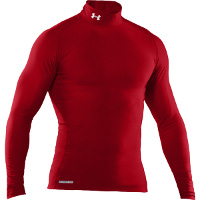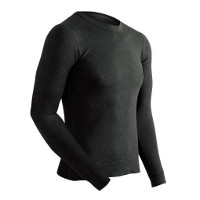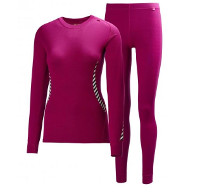Base layers are a critical piece of ski gear, or gear for any outdoor activity in colder weather. When it comes to what to wear skiing, base layers are the foundation for your ski attire planning.
While you ski, your body burns loads of calories and you generate a lot of moisture, even though you might assume you won’t sweat because of how cold it will be when you ski.
Skiers sweat because of exertion — even if it is below freezing. Skiers also develop condensation inside their clothing because of the temperature difference between cold air and warm bodies. Therefore, base layers serve an important purpose for being the mediator between your 98.6 degree body and the shell layers protecting you from the elements.
Another thing that makes staying comfortable difficult for skiers is the variance in temps from minute-to-minute. If you are going down a hard black run, there is a good chance you are getting an aerobic workout and sweating. Then, you sit on a chairlift for 8 minutes and quickly cool off, maybe even get cold. A base layer can be your defense against overheating or chilling.
The Value of Base Layers
Good base layers are made up of wool or synthetic material that helps to draw moisture away from your body during skiing so it can evaporate. Moisture-wicking fabric is very important for skiers (or any athlete, for that matter) because the loss of heat can increase by 5x when a wet garment is against your skin. It is important that any base layer fits snugly against your skin but doesn’t make you feel constricted or that it’s too tight. The reason why you need the layers snug is if your base layers are too lose, they will develops pockets of moist air, and you’ll feel cold.
An ideal base layer is both breathable and makes you feel comfortable. A good base layer should be one that you forget you are wearing during your activity — a great-fitting garment with flat, smooth seams.
Keep in mind that base layers and thermal underwear are not always the same thing. A base layer is meant to feel great against your skin and keep moisture at bay. A thermal layer is meant to keep body heat from escaping. They can be the same thing, but not always. The colder it is, the more you may actually want to consider two layers — base and thermal.
Best Base Layers for Skiers
In our experience, here are the best base layers you can buy for your nordic or downhill skiing (or running, cycling, etc. in cooler weather), based on our understanding of the market.
1. SmartWool NTS mid 250 Zip Thermal

Everyone has one base layer that they reach for again and again, and for us, this is the one. It’s safe to say that with the introduction of SmartWool in 1994, the base layer industrywas revolutionized and they are known worldwide for their exceptional Merino wool clothing products. With 20 years of manufacturing experience you can easily count on their products and they will never let you down. Another quality that separates SmartWool from its competitors is that their products snug perfectly without feeling like a tight fit. This base layer is a one-time investment and will last you more than five years. The NTS Mid 250 gets rave reviews from users, with its heavy construction and shoulder pads that prevent the need for as much stitching. We love that it is warm enough to serve as your only base layer in many settings. If you only buy one base layer, consider making it this one.
Find the bottom here on Amazon.
Pros:
- So comfortable
- Long-lasting
Cons:
- Costs a little more than other options
 2. Under Armour Men’s ColdGear Fitted baselayer
2. Under Armour Men’s ColdGear Fitted baselayer
Everyone knows of Under Armor, their lineup became popular over the past 20 years. One of their timeless lines is the ColdGear base line, which offers just a hint of thermal properties as well. The focus of Under Armor is entirely on synthetic fibers, and they don’t plan to shift to Merino wool anytime soon. Like most of the Under Armor products, these base layers fit perfectly tight and are meant to be worn snug. Having this base layer that is just a little extra tight will keep you warm during skiing while the material absorbs sweat. The bottom line is that Under Armor makes one of the warmest base layers around that are designed especially for skiing. The feel of UA products against the skin is nice – little chance of chafing or discomfort,
Find the leggings here on Amazon.
Pros:
- Coldgear line from UA has proven the test of time; trusted
- Nice, snug fit
Cons:
- May provide too much thermal for warm, sunny ski days
 3. ColdPruf Platinum II Layer
3. ColdPruf Platinum II Layer
Unlike Under Armor and SmartWool, ColdPruf is a less well-known brand, but still provide good ski clothing for those on a budget. We have great admiration for a company that does one thing, and does it really well. ColdPruf’s motto is “We Own Cold”, and they don’t charge an arm and a leg for it. This tight fitting base layer comes in two colors: black and gray. The shirt fits perfectly providing good support and compression. The pants fit snugly around the ankle, ensuring that they stay in place and prevent snow from getting in while you ski. The pants also feature an elastic waist band that keeps a firm hold. The material used in the making of ColdPruf base layers use different fibers, a mixture of polyester and merino wool. It might not be quite a silky smooth as the Smartwool or Helly Hansen, but it also doesn’t cost nearly as much.
Find the bottoms here on Amazon.
Pros:
- Budget-friendly. Quite inexpensive.
- Warm
Cons:
- Not a pure merino wool product – the blend might be slightly less comfortable for som
 4. Helly Hansen HH LIFA Base Layer
4. Helly Hansen HH LIFA Base Layer
Helly Hansen takes pride in being one of the oldest manufacturers of outdoor sports apparel and is quite popular among skiers. They make some of our favorite gear, from kids ski jackets to performance snow pants.
This base layer is not a compression base layer so it suitable for those who have a problem with the tightness of compression base layers (like the Under Armour) or those who find those kinds of base layers become uncomfortable over time. For people who need something that can dry out instantly after getting little sweaty, this base layer, made from synthetic fibers, is a great choice. They are made from propylene, so is very comfortable and soft for extended days on the mountain or cross-country skiing adventures. We especially like how flat it is — everything from the neck to the stitching to the wrist cuffs are low-profile, meaning it will fit nicely under whatever else you layer over it.
Pros:
- Built-for-skiing
- Easy movement while wearing
Cons:
- Thinner – not as warm by itself
5. North Face Winter Warm
North Face does it again with a go-to piece of cold weather clothing. They are right up there with Helly Hansen when it comes to built-for-skiing gear.
The Winter Warm base layer has become a favorite, both for skiing but also for other outdoor activities like cold weather runs. It is made of fleece, and feels great either right against the skin or on top of another thin layer. One of the things we like best about this line, especially the top, is that it looks really good by itself and can be worn as an outer – perhaps on those falls days when you aren’t quite ready for a jacket. You can get the top in a 1/4 zip version, or a classic crew neck. Their lower base layer is one of my favorite things to wear underneath ski pants.
Find the bottom here on Amazon.
Pros:
- Super comfortable
- Looks good worn all by itself
Cons:
- Expensive
Wool or Synthetic Base Layer – Which is Better?
One of the more common questions we receive from readers is if they should center their cold weather wardrobe around wool (particularly merino) or synthetic fabric. If you are counting, our list of 5 recommended base layers includes 2 wool and 3 synthetics, so we like both. We think that if ease of care and low-profile is important to you, consider the synthetics. They tend to be a bit flatter to the skin and are typically able to be washed in any way. If your priority is heat regulation and you prefer to wear something natural, you can’t go wrong with wool. It is one of nature’s best gifts to those of us who spend lots of time in the elements. The beauty of wool is that because of the way nature made it, between 60% – 80% of it is air. That means that moisture can seep into it without making it feel wet against the skin, or compromising its insulating abilities.
Not Cotton
Cotton feels great against bare skin, but that is where the positives end. Anyone who has ever gotten a cotton base layer even the least bit wet or sweaty knows that it is immediately compromised as a thermal layer. Cotton retains water and then holds it against your skin. A wet cotton layer can actually become a liability underneath your snow pants for someone who is attempting to stay warm or regulate their body temp. We do not recommend cotton as a skiing base layer. Instead, save the cotton for the apres-ski night out on the town.
Layer your Layers
Don’t think of a base layer as a one-and-don type of thing. There is nothing wrong with wearing multiple base layers underneath your outer layer or shell. In fact, I do it all the time.
Where I ski, the day can often start at zero or even a few degrees below. This calls for a good base layer against my skin, and another just to make it all more thermal. By 11am, I might be ready to remove one of the base layers, which I do, and then keep on skiing.
Conclusion
Whether you are looking for your alpine ski gear or all-important cross-country skiing staples, a good base layer is a vital requirement. It will keep you warm in the cold as well as being antimicrobial and have wicking properties so that you can be free from the discomfort of sweat. If you are looking for the best features you can find on the market, these 5 base layers are ideal. We would venture out to a day of skiing with any of them. If they made our list, we think they will perform for you.

Paul Miller is the Founder of Family Skier. He is an advanced skier and has extensive experience with family travel and ski schools. An accomplished skier, he has skied in 15 states and provinces and 6 countries. In addition to FamilySkier, his writing can be found on many ski-related websites, and as curriculum for many ski clubs in North America.




